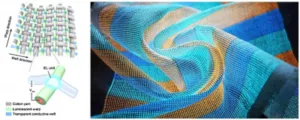An international team of researchers headed by Xiang Shi of Fudan University (Shanghai, China) is developing an interactive display made in the form of an electronic fabric. The fabric has the potential for use in smart clothing.

Up to now, development of such a fabric display has had limited success. One problem is that the integration of conventional video displays into clothing is difficult because such displays tend to be rigid and bulky. A second problem is that the current generation of flexible displays have not proven to be durable or easy to fabricate in a large size.
To address these issues, the researchers adopted an approach in which conductive transparent fibers and luminescent threads are woven together. The result is the formation of micrometer scale electroluminescent pixels at the contact points between the electrically conductive weft threads and the luminescent warp fibers. Also woven into the fabric is cotton yarn with the result being a flexible, breathable fabric. The figure below illustrates the electronic fabric.
On the left: a graphic providing a close up of the fabric structure. On the right: a photograph of the flexible electronic fabric displaying glowing stripes.
A recent article by the team on this topic is entitled “Large-area display textiles integrated with functional systems.” It was published in Nature, Vol. 591 on March 11. A copy of the article is available here.
In this article, the researchers report that they wove swaths of the new fabric display roughly 20 feet long by 10 inches wide. The fabric contains approximately 5 x 105 electroluminescent pixels. The pixels are spaced roughly 800 microns apart.
Due to the fact that the wefts and warps establish a network, each electroluminescent pixel in the textile display can be uniquely selected and lit using an appropriate driving circuit.
The fabric was measured to be about as bright as the average flat screen TV. In addition, the brightness variation between electroluminescent pixels was found to be was less than 8%.
The researchers noted that their prototype fabric was significantly more durable than conventional thin film flexible displays. “The performance for most of the fabric display remained stable after 1,000 cycles of bending, stretching and pressing, and 100 cycles of washing and drying.”
A further feature of the new approach is that the diameter of the light emitting fibers can be precisely adjusted between 0.2 mm and 0.5 mm. This, in turn, allows the electronic fabric to be ultra-fine and ultra-flexible. Fabrics made from these materials can be expected to conform to the irregular contours of the human body and can be as light and breathable as ordinary fabric.
It follows that one likely application for the fabric is wearable displays. “To further investigate this possibility, the researchers incorporated a touch sensitive 16 button fabric keyboard, solar energy harvesting threads and battery fibers into the prototype textile to add interactivity and a power supply. The researchers then added electronics to wirelessly link the fabric to a smartphone via a Bluetooth connection so users could send and receive messages on their sleeves, as well as see their real-time locations on a map.”
In the article, two features of the electronic fabric received particular comment. The first was that the researchers noted the need and discussed the possibility to lower the voltage required to operate the display fabric to less than 36 volts. The concern was that “putting displays with this kind of voltage directly on the body may potentially be a concern.” The second was that power consumption was quite low and heating was negligible. This is obviously necessary for clothing applications.
The team reports that “product models of their fabric are now available and that many companies are in talks to use them.” The researchers conclude their article with the comment that “Our approach unifies the fabrication and function of electronic devices with textiles, and we expect that woven fiber materials will shape the next generation of electronics.” -Arthur Berman
Fudan University, Huisheng Peng, [email protected]

